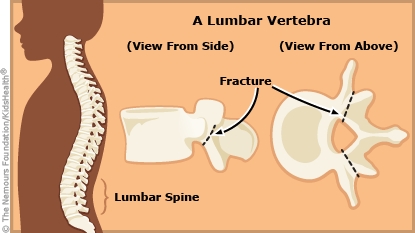Spondylolysis
What Is Spondylolysis?
Spondylolysis is a fracture (crack or break) in a vertebra (bone in the spine). It can happen from repetitive stress or injuries to the spine. Some kids are born with spondylolysis (spon-duh-LOL-uh-sis).
Spondylolysis is a very common cause of lower back pain in kids, teens, and young adults. It usually heals with rest and physical therapy. Surgery usually isn't needed.
How Does Spondylolysis Happen?
The spine (or backbone) has 33 bones called vertebrae (VER-tuh-bray). Nine vertebrae are fused together to form the tailbone, and the other 24 are in the back. The lumbar vertebrae are in the lower back (closest to the tailbone), and are where spondylolysis usually happens.
Spondylolysis is a fracture in the part of the vertebra called the pars (or pars interarticularis). Each vertebra has two pars, one on the left side and one on the right. A spondylolysis, also called a pars defect or stress fracture, can happen on one or both sides of this bone.
What Are the Signs & Symptoms of Spondylolysis?
Lower back pain is the most common symptom of spondylolysis. It usually gets worse during exercise or other physical activity, especially those where someone leans back a lot. Spondylolysis also can cause buttock and leg pain, and tight hamstrings.
Sometimes, kids and teens with spondylolysis won't have any obvious symptoms and don't realize that they have the condition.
Young people are most at risk for spondylolysis because their bones are still growing. Kids and teens who play sports and do activities that can strain the lower back or that involve a lot of leaning back — like football, soccer, weightlifting, gymnastics, volleyball, ballet, golf, and wrestling — are especially prone to this injury.

How Is Spondylolysis Diagnosed?
Health care providers will do an exam. They might push on the back or ask a patient to bend backward to hyperextend the spine. If these things cause back pain, it's possible that there's a fracture in the pars, a specific part of the spine bone.
Other things, such as muscle pain, a pinched nerve, or herniated (bulging) disc, also can cause lower back pain. To rule those out — or to confirm a diagnosis of spondylolysis — health care providers may order tests such as:
- a back X-ray to look for fractures
- a bone scan or a CT (computed tomography) scan, which can detect smaller fractures
- a lumbar MRI scan
How Is Spondylolysis Treated?
Most pain from spondylolysis improves when the condition is caught early and treated properly. If your child has spondylolysis, the health care provider may recommend:
- a break from sports and other strenuous activities
- plenty of rest
- core-strengthening exercises that don't strain the lower back
- flexibility training
- physical therapy
- over-the-counter (OTC) medicine to help ease pain and swelling
- wearing a back brace or support
Most kids and teens will feel better in 3 months, if they follow the health care provider's recommendations. They should wait until they're pain-free and have their full range of motion before playing contact sports or doing strenuous activities.
What Problems Can Happen?
In some cases, spondylolysis can lead to chronic (long-lasting) back pain and loss in flexibility. If this happens, surgery might be needed to fix the problem.
Sometimes, kids with spondylolysis develop a painful condition called spondylolisthesis (spon-duh-low-lis-THEE-sis). This happens when the front part of a vertebra slides away from the back part.
Can Spondylolysis Be Prevented?
Spondylolysis is hard to prevent because it can happen all at once or over time. But young athletes can help lower their risk by:
- limiting time spent on high-risk sports
- resting and recovering after physical activities
- keeping core muscles strong
- warming up properly before playing any sports
- stretching regularly
- using safety equipment correctly
- following the rules and techniques for their sport or activity
- maintaining a healthy weight
What Else Should I Know?
The sports and activities that can cause spondylolysis often are very competitive and attract motivated, driven kids and teens. So it's important to keep your child's temperament in mind when dealing with spondylolysis and its recovery.
Besides their own wishes to return to what they love, kids and teens also might be under pressure to get back into the game from coaches, teammates, and even parents. But a safe return to play is very important. Kids should get the OK from their health care provider before they return to physically demanding activities and sports.
After a spondylolysis diagnosis, kids and teens need to keep up with the proper techniques and sports safety measures they learned in recovery. They should maintain their core strength and flexibility, and take breaks between sports seasons, games, and competitions. Pain from spondylolysis can return if kids do not properly maintain core strength and flexibility.
Also, be sure that your kids know to immediately stop an activity that causes back pain. They should see their health care provider and not return to play until the pain goes away.


